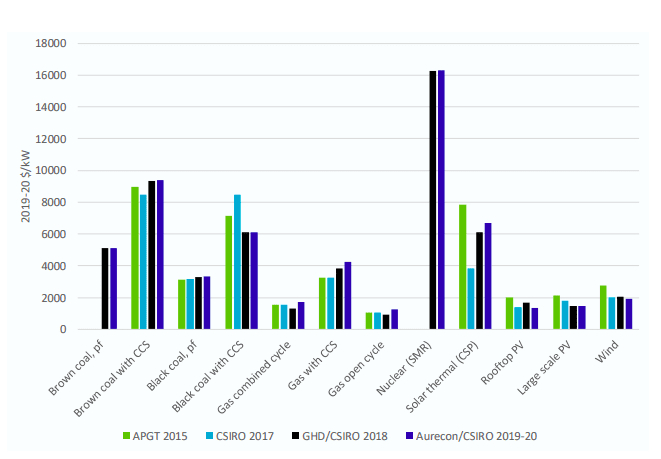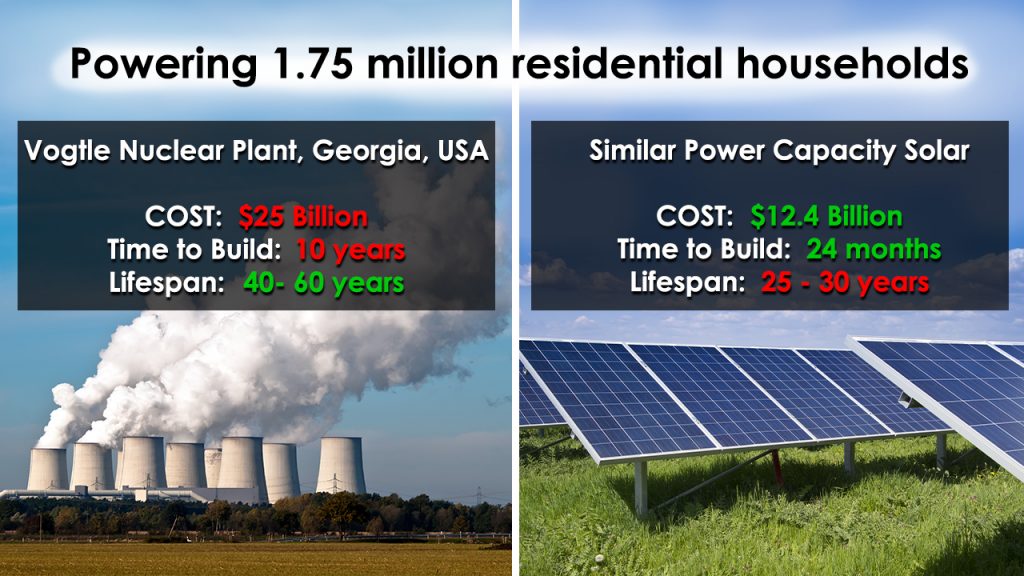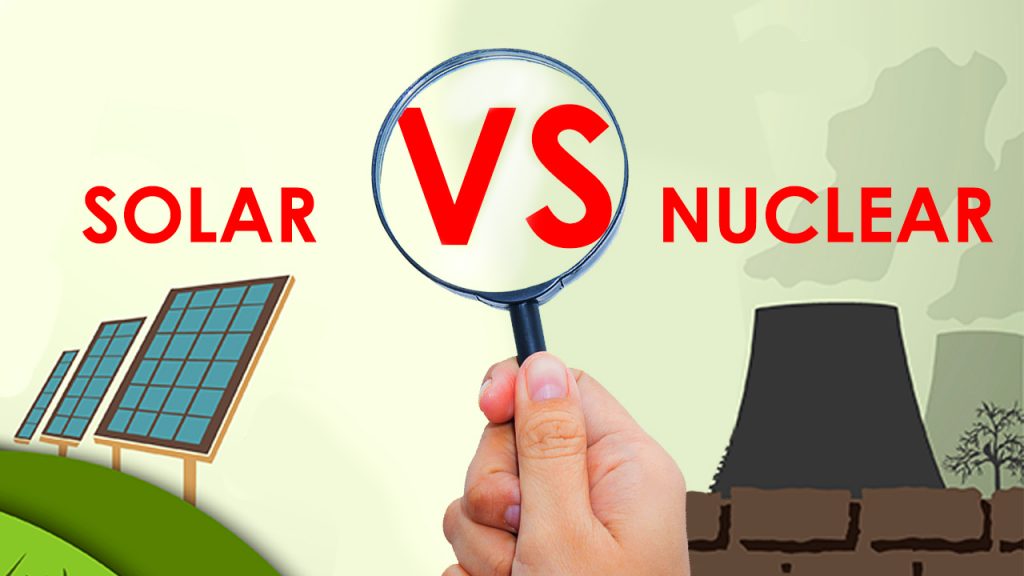Solar Power VS Nuclear Power -Which is better?
What are the similarities between Solar power and Nuclear power?
Solar power vs Nuclear power is an interesting fight, because they have one important thing in common: they are both carbon neutral. Just like solar power plants, nuclear power plants don’t produce greenhouse gases (the culprit for global warming) during operation.
A good example and case study when it comes to nuclear energy is France. France has heavily invested in nuclear energy since the 1980’s and is now producing over 70% of its electricity from nuclear power. That’s an impressive number and it’s more than any other country. Interestingly, the emissions from its electricity sector are one-sixth of the European average, and 11 times less than Australia’s!
Emissions of carbon dioxide per kilowatt-hour of electricity generated:
FRANCE: 57.3 grams
AUSTRALIA: 656.4 grams
So, just like solar, nuclear power is carbon neutral and does not contribute to climate change. However, that’s where the similarities between solar and nuclear end.
It is natural, when considering global warming solutions and renewable energy options, to ask: “Is nuclear better than solar?” That’s a question that many studies have been able to answer with proven and reliable data.
“Should everyone copy France?” -Not really, actually. Read to the end for the reasons why.
Financial cost of Nuclear Energy vs Solar Energy
One of the biggest differences between solar and nuclear is the financial cost. While someone might argue that the financial cost of renewable energy is not as important as reducing our carbon emissions as quickly as possible in view of global warming and its disastrous effects on our planet, it still needs to be considered. The financial weight of a renewable energy solution will determine whether or not a country can actually afford the transition. This is even more important for countries with limited resources who need financially viable solutions to provide clean energy to their emerging populations.
How much does Nuclear Energy cost?
Nuclear is by far the most expensive source of energy out of all the power options available. Its cost is often broken down into capital costs and operating costs. Capital costs includes things such as the preparation of the site, engineering, manufacturing, construction, commissioning and financing. Operating costs include the costs of uranium mining and fuel fabrication, maintenance, decommissioning, and waste disposal (more on that later). The capital cost of nuclear power is much higher than for solar power and the annual cost of repaying the initial investment is much higher than the annual operating costs.
Why is nuclear power so expensive? Because nuclear power plants are technically complex and must satisfy strict design requirements, and its construction requires a lot of very highly qualified specialists and often take many years. Design changes and lawsuits can also increase the financing charges (which in some cases exceed the actual construction costs!) It’s also difficult to predict the cost of a project, because it is very common for nuclear power plants to have “unexpected” are additional costs. A big example of this financial challenge is the 2 unfinished nuclear reactors in South Carolina that were abandoned in 2017 because of difficulties with equipment manufacturing, big construction delays and cost overruns. There are 2 identical reactors under construction in the state of Georgia but their original cost estimate of $14 billion has risen to $23 billion and the only reason it hasn’t been abandoned is because the U.S. government has provided extraordinary financial support for these reactors.
How much does Solar Energy cost?
Multiple studies have concluded that Solar Energy is the cheapest renewable energy solution. But it’s also cheaper than coal and gas! Why is solar so cost effective? For one thing, large scale solar farms don’t require any heavy modifications to the land. Because there is no concrete or any big infrastructures, often times landowners can even decide after 30 years to remove the system and turn it back to its original use -such as farming- with no dramas. This can’t be said about nuclear… Also, the construction of a solar farm requires much less highly qualified personnel and is very straightforward. In addition, the cost of solar is getting cheaper every year. Solar manufacturers are developing panels that are much cheaper to produce while being more effective, and the most expensive element of solar energy (storage) is getting cheaper every year in a drastic way with improvement in the battery technology, which means that solar energy will only be getting more affordable in the future, and will become cheaper than even the dirtiest sources of energy.

Conclusion: Nuclear Power is nearly 10 times more expensive vs solar to build on a cost per KW basis.
An Australian study by CSIRO concluded the following cost in dollar per kilo Watt ($/kW)
Nuclear (SMR): $16,000/kW
Large Scale Solar: $1,349/kW
How long does it take to build Solar Power vs Nuclear Power?
Global warming is an emergency. In Australia alone, we’re already experiencing the terrible effects of green gases warming the environment. 2020 had the largest bushfires ever recorded, the great reef barrier is threatened, and we have one of the highest rates of animal and plant extinction in the world, with only 4 out of 250 countries having lost more animal species than Australia. There is no doubt that we need action now, not in 50 years. So in this race against the doomsday clock, it’s important to consider how long it takes to build solar power plants and how long it takes to build nuclear power plants.
How long does it take to build Solar Energy?
Lazard’s levelized cost of energy analysis finds that utility-scale solar takes about 9 months to complete. However, a few factors can affect how long it takes. For example, land acquisition is a big factor, along with the time needed to get different approvals from the authorities and the size of the array being installed. Other variables affect the timing. Is the land already levelled and clear from trees and bushes?
We find from our research that it can take between 3 to 24 months to build a solar farm.
How long does it take to build Nuclear Energy?
Lazard’s levelized cost of energy analysis finds that nuclear may take 69 months to complete (slightly less than 6 years). The submission by The Australia Institute (TAI) to the South Australian Nuclear Fuel Cycle Royal Commission includes discussion of time taken to build nuclear power plants. The mean time shown is 9.4 years. This number seems a bit more realistic considering the 2 already mentioned nuclear reactors under construction in Georgia, which will only be completed a full decade after receiving their approval.
To Build Solar or To Build Nuclear?
The immediate logical conclusion is that solar power plants are much faster to build than nuclear power plants, which is true. However there is another variable that must be considered, and that is the efficiency of solar vs nuclear. How much energy does nuclear produces each year, and how much energy does solar produce in comparison?
Power sources have two key measurements to their efficiency: their capacity, which is how much power a source can output in megawatts, and their generation, which measures how much energy the power source can supply to the grid in a time period (measured in megawatt per hours, or MWh).
The measure that differentiates solar power to nuclear power is the “capacity factor”, which is how close to the maximum of possible power a source produces through the year. Once built, a nuclear power plant can run at its maximum potential until it needs new fuel, maybe 6 or 12 months later -and generates dangerous nuclear waste that are not being recycled (more on that later). Because of this, the capacity factor of nuclear is close to 100% since it normally produces as much energy as it possibly can 24 hours of the day, every day of the year. Solar power’s capacity factor is far from being this good, because well, it can only produce energy when the sun is out. This reduces its capacity to daytime and makes it vary a lot depending on how much sun the location of the solar farm gets through the year. A solar farm in sunny Queensland will have a much better capacity factor than one say, near Melbourne.
For example, a nuclear power plant the size of the one under construction in Georgia of the capacity of 2,430 MW could be expected to have a capacity factor of 21MWh per year. To reach a similar capacity factor and generate as much power per year, it would require about 13,000MW of capacity in solar farms… So while solar can be built roughly 9-12 times faster than nuclear, we would need to build almost 5 times more capacity to generate the same amount of power through the year. We can expect this number to get better as improvements continue to be developed in this still very new technology, but needing to build this much solar raises another concern: the lifespan of solar panels is between 25 and 30 years, after which they need to be recycled -and we haven’t quite figured out how to recycle them in an efficient way just yet (keep reading). The lifespan of a nuclear power plant, in contrast, is 40 to 60 years (but we can’t really turn the land back to farming when it has gone beyond the expiration date).
To really understand which power options is best regarding cost and time of construction, let’s look at this:

The figures speak for themselves. But remains an important problem and an important question…
Can Solar Panels be Recycled?
Yes. But we need to understand that we’re only starting to face the recycling issue of solar panels, since the first solar panels installed at the beginning of the solar boom are only starting to reach the early end of their lifespan of 25 to 30 years. So we don’t have a very efficient system to recycle them, let alone a system that can be put into the large scale recycling that we’re going to need in a few years, when the quantities of solar panels that will need to be recycled will rise to the tens of millions.
Recycling Photovoltaic panels is a complex task as the way they are manufactured and the adhesives and sealants used make the task of breaking them apart a challenge. But it’s definitely doable, and it’s already being done. Just not very efficiently yet, and we’re making a lot of progress.
A very big positive is that nearly 75% of the material that gets separated out is glass, which is very easy to recycle into new products!
Decommissioning a solar farm is an easy and straightforward process: take the panels out and away we go! The land is not contaminated and because no concrete or infrastructures are built, the land can immediately be used for other purposes -even farming.
Can Nuclear Power Plants and Nuclear Waste be Recycled?
Not really. Used nuclear fuel -or radioactive waste- CAN be recycled to make new fuel and by-products, since about 90% of its potential energy still remains in the fuel even after 5 years of operation in a reactor. The issue is, many countries like the United States -who produces more than 2,000 metric tons of radioactive waste every year- simply don’t recycle their radioactive waste at all. France is the leader in nuclear fuel recycling, with a commercial reprocessing capacity of used fuel of 1,700 tonnes per year while producing 1,150 tonnes per year (4 kilos of radioactive waste per citizen every year!). So, all good? Not really. Globally, radioactive waste is still piling up and becoming a problem. So far, about 400,000 tonnes of used fuel has been discharged globally and only about 30% has been recycled. Even after recycling and reprocessing, a small amount of radioactive waste remains that cannot be recycled yet (and will continue to be radioactive and dangerous for hundreds or thousands of years).
Decommissioning Nuclear power plants is a daunting task at best, and a nightmare often.
Nuclear decommissioning is the administrative and technical process in which a nuclear power plant is dismantled to the point that it no longer requires measures for radiation protection. That’s obviously easier said than done. The progressive demolition of buildings and removal of radioactive material is potentially hazardous, expensive, time-intensive, and presents environmental risks that all need to be addressed. In theory, once a facility is decommissioned no radioactive danger persists and it can be released from regulatory control, which means that the land can be used for anything (including building schools and growing tomatoes). Decommissioning nuclear power plants is so expensive that even rich countries in the European Union are lacking the funds needed. In 2016, the European Commission assessed that European Union’s nuclear decommissioning liabilities were seriously underfunded by about 118 Billion Euros (184 Billion AUD). France (the nuclear star) is now facing big issues and has the largest shortfall in decommissioning funds with only 23 billion euros of earmarked assets to cover 74 billion euros of expected costs (we’re talking about one of the richest countries in the world here…).
How long does it take to decommission a nuclear power plant? Decommissioning a nuclear power plant takes a very long time, sometimes up to 60 years. It’s also a very big task.
While about 99% of the radioactivity of a nuclear power plant is associated with the fuel and this “goes away” when the nuclear waste is disposed somewhere to wait for an eventual recycling, the 1% left radioactivity is found in all the scrap materials, steels, concretes, and even top soil around the nuclear power plant. In France, decommissioning of Brennilis Nuclear Power Plant, a fairly small 70 MW power plant, already cost €480 million (20x the estimate costs) and is still pending after 20 years. Despite the huge investments in securing the dismantlement, radioactive elements such as plutonium, caesium-137 and cobalt-60 leaked out into the surrounding lake.
Because of these challenges, many countries that had invested in nuclear energy have decided to discontinue their usage of nuclear power for energy consumption. The countries who have decided a nuclear phase-out are Austria, Belgium, Germany, Italy, the Philippines, South Korea, Sweden, Switzerland, Slovenia, Taiwan, and Vietnam. Other countries such as Spain and the United Kingdom are currently reviewing the future of their nuclear power. Ireland and Vietnam decided to abandon the construction of their nuclear power plants, Vietnam saying that their nuclear power plants were “not economically viable because of other cheaper sources of power.”
In Australia, nuclear power plants are illegal domestically.
CONCLUSION: SOLAR POWER VS NUCLEAR POWER
While nuclear power produces a lot of energy and is carbon free, it is extremely expensive, takes a long time to build and even longer to decommission, poses issues with recycling radioactive waste and can potentially be dangerous to the population and the environment. In contrast, solar energy is much cheaper, fast to build, does not pose any dangers to the population or contamination to the environment, and is very easy to take apart. The enthusiasm around solar energy is also uplifted by the fact that it’s still a young technology and many improvements in cost and efficiency are to be expected in the years ahead. We also find it very encouraging to know the transition to renewable energy with solar power can be achieved even faster with many people and companies getting their own solar systems to cover their energy needs, reducing their carbon footprint and helping the world to move to a carbon free world faster!
Here are some other links you may find interesting:
Understand the basic of electricity











